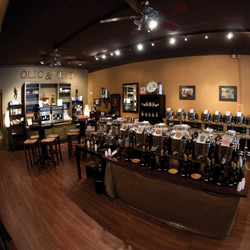The fruit of the olive tree, native to the Mediterranean, has been harvested and turned into oil since the fifth millennium B.C. The revered substance has represented wealth and power in various civilizations, and was deemed “liquid gold” by Homer. It has been used in religious rituals, as fuel in oil lamps, and as an ingredient in medicines, soap and skin care products. Olympians in ancient Greece rubbed olive oil all over their bodies before dusting themselves with sand to help regulate their body temperature and serve as protection from the sun. Throughout the centuries and amidst all of these uses, olive oil has always had a place in the kitchen, and continues to reign there today.
In recent times, the terms extra virgin and virgin have become common distinguishers of the oil’s quality. It’s common knowledge that extra virgin olive oil is the top of the line, but why? And how substantial is the difference between extra virgin and virgin oils? As it turns out, not too much in definition, but a whole lot in taste. Stephanie Brott, owner of Olio & Vino in Peoria Heights, said that it doesn’t take a connoisseur to taste the difference between the two classes of oil—even a beginner can do it.
 From Olives to Oil
From Olives to Oil
Extra virgin olive oil is as pure as it comes. Traditionally, stone presses were used to make olive oil, and extra virgin oil was said to come only from the first press of the fruit. Today, with advances in technology, stone presses aren’t often used in the commercial production of olive oil, and the term has become somewhat obsolete.
When olives arrive at a processing plant, they are washed, and any stems or leaves still attached are removed. Then they are ground into a paste from which oil is released. The paste is mixed for 20 to 45 minutes, during which time heat or water is sometimes added, which increases the yield but reduces the quality of the oil. The paste is then placed in a centrifuge where it’s spun, and gravitational force pulls the oil away from the flesh and water that made up the olives. The extra virgin oil is placed in tanks or barrels where gravity filters any remaining water to the bottom before it is bottled.
Additional steps can then be taken to increase the yield, such as adding chemicals or heat to the paste. The flavor and acidity of defective batches are often improved with chemical or steam processing, and some are even bleached or deodorized. Of course, these would be low-quality oils.
According to the International Olive Council, in order to be considered extra virgin, olive oil must be “obtained only from the olive, the fruit of the olive tree, using solely mechanical or other physical means…which do not alter the oil in any way.” Extra virgin oil can have no more than 0.8-percent free acidity, in terms of oleic acid. “This is your cleanest, your purest, your most expensive, and the best for you,” said Brott. One step down, virgin olive oil must be obtained in the same way, but can contain up to 2-percent free acidity. Ordinary virgin olive oil must have a free acidity of 3.3 percent or less. The Olive Oil Source, an internationally recognized resource on the industry, notes that the U.S. has not yet adopted these standards nationally—although some states have passed laws to enforce them—and still allows lesser oils to be labeled extra virgin.
 A Healthy Alternative
A Healthy Alternative
Extra virgin olive oil is the most sought-after because of its exceptional taste and the health benefits obtained from using it in place of saturated fats. Olive oil contains polyphenols, antioxidants believed to boost the immune system, control blood sugar levels, lower blood pressure, support gastrointestinal and cardiovascular health, and promote weight loss. According to Brott, some industry experts recommend taking a shot of olive oil every day to promote healthier skin, hair and nails. It can even be used externally to enhance and soften skin. Brott said one of her customers claimed rubbing olive oil on his age spots made them disappear. Apparently there are health benefits for animals as well, as olive oil is sometimes added to dogs’ food to combat shedding.
Choosing Your Oil
Many of Olio & Vino’s customers look at the polyphenol count when deciding which oils to take home. Brott noted that those planning to use it for cooking should look for polyphenol counts between 350 and 450, as some of the antioxidants will cook out.
When checking the label, keep an eye on where the oil was made, warns Ryan Wells, manager of Olio & Vino. While there seems to be an attraction to extra virgin olive oil imported from Italy, just because the label says it was imported from Italy doesn’t mean it was made there. For instance, the top three oil-producing countries are Spain, Italy and Greece, but the latter isn’t allowed to export its oil to the U.S. To get around this, Greece first sends its oil to Italy, where it’s packaged and labeled “Imported from Italy.” Just underneath that, said Wells, the label will often say “Harvested and produced in Greece.”
And all those myths you’ve heard about determining olive oil’s quality by its color are exactly that, he said. In fact, the color and appearance of extra virgin olive oil can vary widely, while the flavor is determined by the type of olives used, how ripe they are, the conditions under which they were grown, and how the oil has been stored since production. According to The Olive Oil Source, green, unripe olives produce grassy, artichoke and tomato-leaf flavors, while riper olives produce softer flavors that are more buttery, floral and tropical.
At shops like Olio & Vino, customers can taste before buying, ensuring they get an oil that suits their needs. For the best tasting experience, pour a little oil into a cup. Hold the cup in one hand and cover it with the other while swirling the oil to release its aroma. Uncover the cup and immediately inhale the scent while slurping the oil into your mouth. A bit uncouth, slurping will allow air and oil to enter your mouth, producing the best experience for your taste buds.
“This is not just a retail shop,” Brott said of Olio & Vino, emphasizing that they try to educate their customers on the benefits and trends of extra virgin olive oil. There, you can taste nearly 20 varieties of oil and get the one that will reign in your kitchen. iBi


